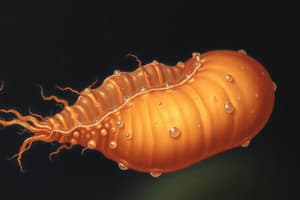Podcast
Questions and Answers
Amoeba is classified under algae.
Amoeba is classified under algae.
False (B)
Trophozoite has a fixed shape.
Trophozoite has a fixed shape.
False (B)
All amoebas are parasitic.
All amoebas are parasitic.
False (B)
Cysts are the reproductive form of amoeba.
Cysts are the reproductive form of amoeba.
Entamoeba histolytica is found only in tropical areas.
Entamoeba histolytica is found only in tropical areas.
Infection with Entamoeba histolytica occurs through contact with contaminated soil.
Infection with Entamoeba histolytica occurs through contact with contaminated soil.
Naegleria fowleri is a parasitic amoeba.
Naegleria fowleri is a parasitic amoeba.
Iodamoeba butschii is a parasitic amoeba.
Iodamoeba butschii is a parasitic amoeba.
Acanthamoeba is a medically important free-living amoeba.
Acanthamoeba is a medically important free-living amoeba.
Entamoeba coli is a parasite capable of causing extra-intestinal infection.
Entamoeba coli is a parasite capable of causing extra-intestinal infection.
Entamoeba coli trophozoites are smaller than Entamoeba histolytica trophozoites.
Entamoeba coli trophozoites are smaller than Entamoeba histolytica trophozoites.
Entamoeba coli has a sluggish motility.
Entamoeba coli has a sluggish motility.
Entamoeba coli is commonly found in the liver, lung, and brain.
Entamoeba coli is commonly found in the liver, lung, and brain.
Entamoeba coli cysts are smaller than Entamoeba histolytica cysts.
Entamoeba coli cysts are smaller than Entamoeba histolytica cysts.
Entamoeba coli trophozoites have a unidirectional motility.
Entamoeba coli trophozoites have a unidirectional motility.
Entamoeba coli contains red blood cells in its cytoplasm.
Entamoeba coli contains red blood cells in its cytoplasm.
Entamoeba coli nucleus has an even thickness membrane.
Entamoeba coli nucleus has an even thickness membrane.
Entamoeba coli mature cysts have 1 to 4 nuclei.
Entamoeba coli mature cysts have 1 to 4 nuclei.
The size range of Entamoeba histolytica trophozoite is 8-10µm.
The size range of Entamoeba histolytica trophozoite is 8-10µm.
Entamoeba histolytica trophozoite has multiple nuclei.
Entamoeba histolytica trophozoite has multiple nuclei.
The karyosome in Entamoeba histolytica trophozoite is large and peripheral.
The karyosome in Entamoeba histolytica trophozoite is large and peripheral.
Entamoeba histolytica trophozoite is not motile.
Entamoeba histolytica trophozoite is not motile.
The cytoplasm of Entamoeba histolytica trophozoite is coarsely granular.
The cytoplasm of Entamoeba histolytica trophozoite is coarsely granular.
Entamoeba histolytica trophozoite can survive in the stomach and cause infection.
Entamoeba histolytica trophozoite can survive in the stomach and cause infection.
The cyst of Entamoeba histolytica has a spherical shape and 1-4 nuclei.
The cyst of Entamoeba histolytica has a spherical shape and 1-4 nuclei.
The chromatid bars are seen in mature cysts of Entamoeba histolytica.
The chromatid bars are seen in mature cysts of Entamoeba histolytica.
The life span of Entamoeba histolytica trophozoite is up to 24 hours at 37°C.
The life span of Entamoeba histolytica trophozoite is up to 24 hours at 37°C.
Entamoeba coli trophozoite has a small eccentric karyosome.
Entamoeba coli trophozoite has a small eccentric karyosome.
Trichrome staining is used to visualize the nucleus of Entamoeba coli.
Trichrome staining is used to visualize the nucleus of Entamoeba coli.
Endolimax nana trophozoite contains erythrocytes.
Endolimax nana trophozoite contains erythrocytes.
Iodamoeba bütschlii is a widely distributed and common parasite.
Iodamoeba bütschlii is a widely distributed and common parasite.
Entamoeba coli cyst has a single nucleus.
Entamoeba coli cyst has a single nucleus.
Endolimax nana cyst has a large central karyosome.
Endolimax nana cyst has a large central karyosome.
Entamoeba coli trophozoite has a thin nuclear membrane.
Entamoeba coli trophozoite has a thin nuclear membrane.
Endolimax nana trophozoite has rapid motility.
Endolimax nana trophozoite has rapid motility.
Iodamoeba bütschlii is a common parasite in tropical areas.
Iodamoeba bütschlii is a common parasite in tropical areas.
Endolimax nana trophozoites have a ectoplasm differentiated from endoplasm
Endolimax nana trophozoites have a ectoplasm differentiated from endoplasm
Iodamoeba bütschlii cysts are multinucleated
Iodamoeba bütschlii cysts are multinucleated
Blastocystis hominis accumulates starch and not filled in granules
Blastocystis hominis accumulates starch and not filled in granules
Cyst of Blastocystis hominis has a large central body surrounded with a thick inner membrane of cyst wall
Cyst of Blastocystis hominis has a large central body surrounded with a thick inner membrane of cyst wall
The diagnostic stage of intestinal amoeba is the trophozoite stage
The diagnostic stage of intestinal amoeba is the trophozoite stage
Iodamoeba bütschlii cysts do not have a large glycogen vacuole
Iodamoeba bütschlii cysts do not have a large glycogen vacuole
The infective stage of intestinal amoeba is the trophozoite stage
The infective stage of intestinal amoeba is the trophozoite stage
Endolimax nana has a large central karyosome in its nucleus
Endolimax nana has a large central karyosome in its nucleus
Blastocystis hominis is a parasitic amoeba with a worldwide distribution
Blastocystis hominis is a parasitic amoeba with a worldwide distribution
Flashcards are hidden until you start studying
Study Notes
Amoeba: General Characteristics
- Classified under protozoa
- No fixed shape due to pseudopodia extension for motility and phagocytosis
- Cytoplasm bounded by a membrane, comprising outer ectoplasm and inner endoplasm
- Both free-living and parasitic forms exist, with parasitic forms causing amoebiasis
- Found in digestive systems, with common species including Entamoeba, Endolimax, and Iodamoeba
- Motility achieved through crawling or gliding
- Reproduction occurs through fusion and budding
Medically Important Amoeba
- Intestinal amoeba: Entamoeba histolytica, Entamoeba dispar, Entamoeba coli, and others
- Free-living amoeba: Naegleria fowleri, Acanthamoeba spp., and Balamuthia mandrillaris
- Opportunistic pathogens: Acanthamoeba spp. and Balamuthia mandrillaris
Entamoeba histolytica
- Worldwide distribution, common in tropical areas
- Infection occurs through ingestion of water and food containing cysts, via oral-fecal route
- Morphology:
- Trophozoite: 8-65µm, irregular shape, actively motile with finger-like pseudopodia, and a single nucleus
- Cyst: 8-22µm, spherical to round, 1-4 nuclei, and finely granular cytoplasm
Entamoeba coli
- Distribution: worldwide
- Non-pathogenic commensal
- Larger than E. histolytica (20-50 µm)
- Sluggish motility
- Life cycle similar to E. histolytica
- Inhabits the lumen of the large intestine
- Often confused with E. histolytica
Entamoeba coli vs. Entamoeba histolytica
- Trophozoite size and motility
- Cytoplasmic features (clear ectoplasm and granular endoplasm in E. histolytica)
- Nucleus size and karyosome position
- Cyst size and number of nuclei
Endolimax nana
- Trophozoite: small (6-15 µm), clear ectoplasm, and granular endoplasm
- No erythrocyte presence
- Nucleus: large central karyosome
- Sluggish motility
- Cyst: small (8-10 µm), oval, 1-4 nuclei, and eccentric karyosome
Iodamoeba bütschlii
- Widely distributed, less common than E. coli and E. nana
- Trophozoite: small (6-25 µm), no differentiated ectoplasm, and central karyosome
- Cyst: 8-15 µm, oval, 1 nucleus, large central karyosome, and glycogen vacuole
Blastocystis hominis
- Worldwide distribution
- Size: 2-100 µm
- Yeast-like form
- Can accumulate starch and fill granules
- Cyst: large central body, thin inner membrane, and dense inclusions
Studying That Suits You
Use AI to generate personalized quizzes and flashcards to suit your learning preferences.




